Abstract
Esophageal squamous cell carcinoma (ESCC) is a kind of malignant tumor with high incidence and mortality in the digestive system. The aim of this study is to explore the function of lnc-ABCA12-3 in the development of ESCC and its unique mechanisms. RT-PCR was applied to detect gene transcription levels in tissues or cell lines like TE-1, EC9706, and HEEC cells. Western blot was conducted to identify protein expression levels of mitochondrial apoptosis and toll-like receptor 4 (TLR4)/nuclear factor kappa-B (NF-κB) signaling pathway. CCK-8 and EdU assays were carried out to measure cell proliferation, and cell apoptosis was examined by flow cytometry. ELISA was used for checking the changes in glycolysis-related indicators. Lnc-ABCA12-3 was highly expressed in ESCC tissues and cells, which preferred it to be a candidate target. The TE-1 and EC9706 cells proliferation and glycolysis were obviously inhibited with the downregulation of lnc-ABCA12-3, while apoptosis was promoted. TLR4 activator could largely reverse the apoptosis acceleration and relieved the proliferation and glycolysis suppression caused by lnc-ABCA12-3 downregulation. Moreover, the effect of lnc-ABCA12-3 on ESCC cells was actualized by activating the TLR4/NF-κB signaling pathway under the mediation of exosome. Taken together, the lnc-ABCA12-3 could promote the proliferation and glycolysis of ESCC, while repressing its apoptosis probably by regulating the TLR4/NF-κB signaling pathway under the mediation of exosome.
Esophageal cancer is one of the most usual cancers in the world with the sixth highest mortality rate among all cancers [1]. The pathological types of esophageal cancer include squamous cell carcinoma, adenocarcinoma and undifferentiated small cell carcinoma, of which esophageal squamous cell carcinoma (ESCC) accounts for the majority [2]. ESCC is mainly treated by surgery supplemented with chemotherapy and radiotherapy, while the treatment effect of advanced esophageal cancer is not ideal [3]. At present, there are five auxiliary diagnostic methods for esophageal cancer including esophageal barium contrast, endoscopy, radionuclide examination, tracheoscopy and chest and abdomen CT examination [4]. However, the current mainstream diagnostic means cannot be widely used to screen patients with early esophageal cancer, resulting in the majority of patients have developed to the middle and late stage when diagnosed. Previous researches have shown that treatment of esophageal cancer patients with early diagnosis depicted a significantly better prognosis than the middle and late patients [5]. Therefore, early intervention in the development of esophageal cancer is of great significance to improve its prognosis.
Almost all kinds of cells including tumor cells can secrete a double lipid membrane structure known as exosomes, which contain a variety of nucleic acid molecules from mother cells including long non-coding RNA (lncRNA), mRNA and miRNA [6]. Recent studies have demonstrated that exosomes are involved in cell migration [7], extracellular information exchange [8], cell differentiation and invasion in tumor microenvironment [9]. Moreover, exosomes released by tumor cells have been found in peripheral blood of patients with esophageal cancer, prostate cancer, breast cancer and other tumors [10]. LncRNAs are a type of RNA molecules with surpass 200 nucleotides in length without protein-coding functions [11]. According to previous studies, lncRNA MALAT-1 [12], PCAT-1 [13] and TUG1 [14] have been proved to be closely connected with the occurrence and development of ESCC. LncRNAs like lncRNA XIST could promote the aggressive tumor phenotype and was associated with poor prognosis in ESCC [15]. Till now, a multi-lncRNA has accredited for suvival prediction in ESCC patients [16]. Recently, a novel lncRNA, lnc-ABCA12-3, was founded to be overexpressed in ESCC tissues and could interfere with the cell proliferation, invasion and differentiation [17]. However, the specific relationship between ESCC and lnc-ABCA12-3 and the unique mechanism therein remains uncovered.
Toll-like receptor 4 (TLR4), known as a key molecule in innate immune response, recognized the pathogen-associated molecular patterns and danger-associated molecular patterns before activating the pro-inflammatory nuclear factor kappa-B (NF-κB) [18]. LncRNA could benefit for the inflammatory development under the impact of TLR4/NF-κB signaling pathway in osteoarthritis and ESCC [19,20]. In some cases, the apoptosis of ESCC was due to the imbalance of mitochondrial pathway [21]. Interestingly, TLR4 activation could promote the mitochondrial dynamic imbalance and damage to some extent [22]. Besides, excessive activation of glycolysis could mediate the progression and the metastasis of ESCC through mitochondrial function and NF-κB/COX-2/VEGF axis [23].
In the present study, through gene-chip analysis, it was found that lnc-ABCA12-3 was overexpressed in ESCC tissues. Further studies showed that lnc-ABCA12-3 was upregulated in the serum of ESCC patients and the exosomes in the serum. Importantly, exosome-derived lnc-ABCA12-3 enhanced cell viability and glycolysis, and restrained apoptosis by regulating TLR4/NF-κB signaling pathway in ESCC. Lnc-ABCA12-3 might be considered as a candidate target favoring the early diagnosis and treatment for ESCC.
ESCC cell line TE-1 (affandi-e, X120245), EC9706 (affandi-e, X120243), HEEC (affandi-e, X120567) were conventionally cultured using the RPMI-1640 medium (Gibco, Grand Island, NY, USA, 11875119) supplied with 10% FBS (Gibco, 10099-141). For culture conditions, cells were hatched in a constant temperature incubator (Thermo Fisher Scientific, Waltham, MA, USA) at 37°C with 5% CO2. Exosome was separated using the total exosome isolation reagent (Thermo Fisher Scientific, 4478359). Then the specialized non-exosome medium was collected for other use.
Clinical data were collected from 30 patients with ESCC receiving palliative surgical resection in the Second Department of Thoracic of Hunan Cancer Hospital. The normal tissues were collected from the paracancer tissues of the same patient (> 2.0 cm from the edge of the tumor tissue) and no residual cancer cells were found on the resection edge by postoperative pathological diagnosis. The serum samples were collected from ESCC patients and healthy volunteers. All samples were frozen in a liquid nitrogen tank for 24 h after acquisition, and then placed in a –80°C refrigerator for subsequent experiments. The degree of tumor differentiation and staging were determined according to the standards of the 7th edition staging system released by the International Union Against Cancer in 2009. All the selected patients signed the informed consent form. All relevant operations were approved by the Institutional Ethics Committee of Hunan Cancer Hospital (approval No. KLL-2020-131) and consistent with the relevant regulations.
Total RNA of the ESCC tissues and adjacent normal tissues were extracted with RNA enzyme inhibitor RNAiso Plus and delivered to Shanghai Kangcheng Biological Co., LTD for chip service. First, rRNA and DNA were removed from 1 μg of total RNA, then the template was amplified and reversely transcribed into fluorescent cDNA with random primers. The labeled cDNA was hybridized with Human LncRNA Array v3.0 (8 × 60K; Arraystar, Rockville, MD, USA), the chip was washed, and the fluorescence signal intensity of the chip was scanned by a GenePix4000B chip scanner (Molecular Devices, San Jose, CA, USA). Finally, GenePix Pro V6.0 (Molecular Devices) was used for hierarchical clustering analysis of raw data. The screening conditions for differentially expressed genes were as follows: |Fold| ≥ 2, p < 0.05, and false discovery rate (FDR) < 0.05.
A TRIzol reagent (Life Technologies, Carlsbad, CA, USA) was used to extract the total RNA. Then RNA was reverse‐transcribed with the HiScript 1st Strand cDNA Synthesis Kit (R111-01; Vazyme, Nanjing, China). qRT-PCR was executed with a AceQ Universal SYBR qPCR Master Mix (Q511-02; Vazyme). The primer sequences were shown as follow: GAPDH sense primer 5’-ACAGCCTCAAGATCATCAGC-3’ and the antisense primer 5’-GGTCATGAGTCCTTCCACGAT-3’, lnc-ABCA12-3 sense primer 5’-TGTGTGTCCTCCCATTTCCAGT-3’ and the antisense primer 5’-GCACCACTTTGCCACTCTCTTC-3’. GAPDH is used as an internal parameter. 2-ΔΔCt was used to calculate the relative mRNA expression level.
Short hairpin RNAs (shRNAs) of lnc-ABCA12-3 was constructed into a lentiviral vector (GeneChem, Shanghai, China), and a blank load transfection was sited as the negative control. The sequence against lnc-ABCA12-3 was as follows: 5’‐CCAAGATGCAAAGAAACAT‐3’. The shRNA in the lentiviral vector was transfected into cells using Lipofectamine 2000 (Invitrogen, Carlsbad, CA, USA) according to the manufacturer’s protocol. The transfection efficiency was evaluated by qRT-PCR.
Cell proliferation was evaluated by cell counting kit‐8 (CCK-8, Beyotime Biotechnology, Shanghai, China) and EdU Kit (C10310-1, RiboBio, Guangzhou, China). For CCK-8 assay: 1 × 104/ml single cell suspensions were inoculated into 96 well culture plates with 100 μl per well, and cultured for 0, 24, 48, and 72 h, respectively. The original medium was discarded, and 100 μl 10% CCK-8 solution was added to each well for 2 h. Then the absorbance was measured at 450 nm using a microplate reader (Thermo Fisher Scientific). The experiment was repeated 3 times in each group.
Glucose oxidase method [24] was used to measure glucose concentration and calculate its consumption. The experiment was repeated for 3 times in each group, and the average value was taken. ATP detection kit (S0026; Beyotime Biotechnology) was used to measure the amount of ATP production in cells. The cells culture medium was discarded and cells were lysed to obtain the cell suspension before reaction substrates added and fluorescence values measuring. Lactose synthesized was examined using high-performance anion-exchange chromatography [25,26].
After 48 h of transfection, cells in each group were collected through centrifugation at 4°C for 5 min at 1,000 r/min, then washed twice by PBS. The cell concentration was adjusted to 1 × 106/ml. Staining was performed according to the instructions of Annexin V/PI kit, and cell apoptosis was detected by flow cytometry. Cells in each group were tested in triple.
The total protein content was extracted using RIPA reagent (Beyotime Biotechnology) before subjected to SDS-PAGE with an equal amount. After transferred, the membranes were blocked with 5% skim milk powder in PBST for 1 h at room temperature. Then, the membranes were immune-stained with 1:1,000 diluted anti-Bcl-2 (Abcam, Cambridge, MA, USA, ab182858), anti-Bax (Abcam, ab32503), anti-Caspase-3 (Abcam, ab32351), anti-Cleaved Caspase-3 (Abcam, ab32042) and anti-GAPDH (Abcam, ab8245) overnight at 4°C, respectively. The membranes were washed with PBST and incubated with corresponding horseradish peroxidase-conjugated 1:5,000 goat anti‐mouse secondary antibodies. The bands were measured and analyzed by using a MiniChemi imaging system (SINSAGE, Guangzhou, China) and the ImageJ software (National Institutes of Health, Bethesda, MD, USA).
For three or more independent trials in this study, data were presented as mean ± standard deviation (SD). Significant differences were identified using factorial analysis of Student’s t-test (two groups) and analysis of variance (multiple groups). SPSS 22.0 software (IBM Co., Armonk, NY, USA) was used for statistical analysis. p < 0.05 is considered significant and is indicated by an asterisk in the bar chart.
The lncRNA expression profile of ESCC tissues and adjacent normal esophageal tissues were primarily detected. Volcanic diagram depicted the differential distribution of lncRNAs expression changes in ESCC tissues and normal adjacent tissues. The red and blue area points in the figure represent the lncRNA whose expression changes were greater than 2, and p-value was less than 0.05 (Fig. 1A). The top 10 differentially expressed lncRNAs of upregulation or downregulation were showed in heat map (Fig. 1B). As the qRT-PCR results shown, lnc‐ABCA12‐3 was significantly overexpressed in ESCC tumor tissues comparing the adjacent normal esophageal tissues (Fig. 1C). Besides, lnc‐ABCA12‐3 expression in patient serum and serum exosomes were both obviously elevated compared to their normal controls, respectively (Fig. 1D, E). ESCC cell lines TE-1 and EC9706 were used for the following in vitro test according to their higher lnc‐ABCA12‐3 expression levels than the HEEC cell line (Fig. 1F).
To investigate the function of lnc‐ABCA12‐3 in ESCC, lnc-ABCA12-3 in both TE-1 and EC9706 cells were downregulated using shRNA. As the results shown, expression of lnc-ABCA12-3 in sh-ABCA12‐3 group was significantly decreased compared to the sh-NC group and the blank control group (Fig. 2A). It was worth noting that proliferation and glycolysis of sh-ABCA12-3 group in either TE-1 or EC9706 cells were all obviously inhibited after downregulation of lnc-ABCA12-3 (Fig. 2B–G), while the cells apoptosis were advanced to a conspicuous level (Fig. 3A, B). To uncover the possible relevancy between lnc-ABCA12-3 and ESCC and the potential mechanisms therein, mitochondrial apoptosis-related proteins and TLR4/NF-κB signaling pathway relevant proteins were detected. Results depicted that expression of Bcl-2 was restrained, while the Bax and cleaved caspase-3 expression levels were enhanced in both TE-1 and EC9706 cells (Fig. 3C, D). As for TLR4/NF-κB signaling pathway, TLR4, P-IκBa and p-NF-κB were all down-regulated (Fig. 4).
To explore the mechanisms of lnc-ABCA12-3 impact on ESCC, sh-NC and sh-ABCA12-3 of TE-1 cells were separately disposed with lipopolysaccharide (LPS) (S1732; Beyotime Biotechnology), a specific activator of TLR4 [27]. As the results shown, cell proliferation of TE-1 could be accelerated to some degree on effect of the TLR4 activator, and it could also dismiss the cell proliferation inhibition induced by sh-lnc-ABCA12-3 (Fig. 5A–C). TLR4 activator could promoted the cell glycosis while its influence on cell apoptosis was not significant. Besides, TLR4 activator could obviously relieved the glycosis suppress and the apoptosis acceleration on basis of the dates compared to their controls, respectively (Fig. 5D–H). Among mitochondrial apoptosis-related proteins, expression of Bcl-2 was enhanced while expression of Bax and cleaved caspase-3 were notably decreased in the sh-ABCA12-3 + TLR4 activator group comparing the sh-ABCA12-3 group. Bcl-2 expression in the TLR4 activator group was partly elevated compared with the sh-NC group (Fig. 6A). For TLR4/NF-κB signaling pathway related proteins, expression levels of TLR4, p-IκBa and p-NF-κB in the TLR4 activator group were obviously upregulaed compared with the sh-NC group. However, their expression levels were dramatically improved in the sh-ABCA12-3 + TLR4 activator group comparing to the sh-ABCA12-3 group (Fig. 6B).
To further investigate the manner of lncABCA12-3 function to ESCC, TE-1 cells were still used and disposed with exosomes separated from itself with or without the sh-lncABCA12-3. As the results shown, expression levels of lncABCA12-3 were primarily confirmed in the control group (TE-1 cells were treated by PBS), TE-1-exo group (TE-1 cells were treated by exosomes from TE-1 cells), CM group (TE-1 cells were treated by conditioned culture medium without exosomes), sh-NC-TE-1-exo group (TE-1 cells were treated by exosomes from sh-NC transcribed TE-1 cells) and sh-ABCA12-3-TE-1-exo (TE-1 cells were treated by exosomes from sh-ABCA12-3 transcribed TE-1 cells). Compared with control group, lncABCA12-3 expression was raised in TE-1-exo group, while elimination of exosomes or silencing of sh-ABCA12-3 attenuated the effect (Fig. 7A). Cell proliferation and glycolysis were significantly enhanced in TE-1-exo group compared to the control group, and elimination of exosomes reversed the effect. Moreover, both cell proliferation and glycolysis were suppressed in sh-ABCA12-3-TE-1-exo group compared to the sh-NC-TE-1-exo group (Fig. 7B–G). For mitochondrial apoptosis-related proteins, expression of Bcl-2 was improved under the occurrence of exosome, while the expression of Bax and cleaved caspase-3 were inhibited concurrently. However, once the lncABCA12-3 was knocked down, the effects were restored (Fig. 8A). In TLR4/NF-κB signaling pathway, expression levels of TLR4, p-IκBa and p-NF-κB all could be facilitated under the function of exosome (TE-1-exo group) compared with the control group. While this status could be reversed after lncABCA12-3 down-regulated (Fig. 8B).
ESCC was a domestic epidemic malignant tumor, its clinical examination was given priority to with esophagoscope and gastroscope. While most patients in the non-symptoms early period showed rare desiderate to do this examination due to the special characteristics of these methods. The other detection methods as serological markers detection of p53 and carcinoembryonic antigen screening presented low sensitivity and specificity which made the early diagnosis of ESCC more difficult [28]. Previous studies have better revealed the pathological and physiological mechanisms of ESCC, thus further elucidated the pathogenesis of ESCC and found a non-invasive, effective, sensitive and highly specific detection method in the clinic was of great significance for the early screening, prognosis judgment and targeted treatment of ESCC.
LncRNAs abnormally expressed in varieties of tumors and were closely related to their occurrences and developments thus always served as a potential biomarker. Using hepatocellular carcinoma specific cDNA microarray technology, lncRNA HULC was founded highly expressed in hepatocellular carcinoma tissues and serum, and expression of several hepatocellular carcinoma related genes was changed after the expression of HULC was interfered [29]. In addition, the increased expression of lncRNA PCGEM1 also could promote the proliferation of prostate cancer cells [30]. Recently, expression profiles of lncRNAs in ESCC had also been focused, which provided a certain basis for clarifying the molecular mechanism of ESCC occurrence and development. For instance, CASC9 and LINC01980 could act as a promoter in ESCC progress [31,32]. LncRNA PART1 functioned in else aspects as the gefitinib resistance in ESCC [33]. Lnc-ABCA12-3, a new noticed lncRNA, once was demonstrated to facilitate the cell invasion, migration and proliferation under the influence of fibronectin 1 in ESCC [34]. However, other unique roles of lnc-ABCA12-3 in ESCC remained to be further explored. In this study, the lncRNA expression profile of ESCC tissues and adjacent normal esophageal tissues were detected and lnc-ABCA12-3 was higher expressed in ESCC tumor tissues, patient serum and serum exosomes. LncRNA PEG10 was detected to be highly expressed in 43 ESCC patients tissues and positively correlated with lymph node metastasis and tissue differentiation, while tumor proliferation and infiltration were inhibited after its down-regulation [35]. To uncover the role of lnc-ABCA12-3 in ESCC, lnc-ABCA12-3 was silenced in TE-1 and EC9706 cells. The cell proliferation and glycolysis were repressed, while cell apoptosis was promoted. Multiple lncRNAs like GAS5 [36], MEG3 [37] and SNHG20 [38] could accelerate tumor cell apoptosis by interfering the mitochondrial apoptosis pathway. The mitochondrial apoptosis related proteins were also examined in this study, the down-regulated of Bcl-2 and elevated expression of Cleaved caspase-3 indicated that cells apoptosis of TE-1 and EC9706 after lnc-ABCA12-3 knock-down were probably related to mitochondrial apoptosis.
Previous studies demonstrated that lncRNA FTH1P3 could regulate the metastasis and invasion of ESCC through NF-κB pathway and TGF-beta-induced NKILA could also inhibit ESCC cell migration and invasion in the same way [39,40]. To investigate the possible mechanism of lnc-ABCA12-3 impact on the ESCC, pivotal proteins in TLR4/NF-κB signaling pathway were detected, among which expression of TLR4, P-IκBa and p-NF-κB were enhanced. This gave a support for lnc-ABCA12-3 function to the ESCC by regulating the TLR4/NF-κB signaling pathway. To further confirm this hypothesis, a TLR4 activating model was conducted as previous executed [41]. The TLR4 activator could promote the cell proliferation and compensate the repression of glycolysis and proteins expression in mitochondrial apoptosis pathway and TLR4/NF-κB signaling pathway resulting from the lnc-ABCA12-3 knock-down. LncRNAs always served as a kind of biomarker basing on its signature in exosomes [42]. LncRNA PART1 had been proved can induce gefitinib resistance in ESCC under mediation of exosome via functioning as a competing endogenous RNA [33]. To figure out the manner of lnc-ABCA12-3 acting on the ESCC, exosome with higher lnc-ABCA12-3 levels were extracted and disposed with ESCC cells. As results depicted, the proliferation and glycolysis of ESCC were significantly increased and cells apoptosis were repressed, reversing to the status of lnc-ABCA12-3 knock-down. Besides, these favorable appearances could be eliminated again after silencing of lnc-ABCA12-3. In cardiac fibroblasts, exosomal lncRNA AK139128 derived from the hypoxic cardiomyocytes could promote the cell apoptosis and inhibit the cell proliferation [43]. This was consistent to our findings of lnc-ABCA12-3. In this study, the function of lnc-ABCA12-3 in ESCC was focused on the TLR4/NF-κB signaling pathway due to its dependency with the tumor occurrence and development [44]. However, whether the lnc-ABCA12-3 aspect in ESCC with this unitary way or not remained to be discussed, and our results required more validations in vivo as favor. These will be under the focus in our future work.
To sum up, lnc-ABCA12-3 was screened from the numerous abnormal expression lncRNAs, and demonstrated to facilitate proliferation and glycolysis while suppress the apoptosis in ESCC by regulating the TLR4/NF-κB signaling pathway. The impact of lnc-ABCA12-3 on ESCC was under the mediation of exosome.
Notes
REFERENCES
1. Tang L, Zhao S, Liu W, Parchim NF, Huang J, Tang Y, Gan P, Zhong M. 2013; Diagnostic accuracy of circulating tumor cells detection in gastric cancer: systematic review and meta-analysis. BMC Cancer. 13:314. DOI: 10.1186/1471-2407-13-314. PMID: 23806209. PMCID: PMC3699416. PMID: https://www.scopus.com/inward/record.uri?partnerID=HzOxMe3b&scp=84879457033&origin=inward.
2. Qi YJ, Chao WX, Chiu JF. 2012; An overview of esophageal squamous cell carcinoma proteomics. J Proteomics. 75:3129–3137. DOI: 10.1016/j.jprot.2012.04.025. PMID: 22564818. PMID: https://www.scopus.com/inward/record.uri?partnerID=HzOxMe3b&scp=84861668900&origin=inward.
3. Hirano H, Kato K. 2019; Systemic treatment of advanced esophageal squamous cell carcinoma: chemotherapy, molecular-targeting therapy and immunotherapy. Jpn J Clin Oncol. 49:412–420. DOI: 10.1093/jjco/hyz034. PMID: 30920626. PMID: https://www.scopus.com/inward/record.uri?partnerID=HzOxMe3b&scp=85067627904&origin=inward.
4. Zhang R, Lau LHS, Wu PIC, Yip HC, Wong SH. Lam AK, editor. 2020. Endoscopic diagnosis and treatment of esophageal squamous cell carcinoma. Esophageal squamous cell carcinoma: Methods in molecular biology. Humana;New York: p. 47–62. https://link.springer.com/protocol/10.1007/978-1-0716-0377-2_5. DOI: 10.1007/978-1-0716-0377-2_5. PMID: 32056169. PMID: https://www.scopus.com/inward/record.uri?partnerID=HzOxMe3b&scp=85079361603&origin=inward.
5. Fatehi Hassanabad A, Chehade R, Breadner D, Raphael J. 2020; Esophageal carcinoma: towards targeted therapies. Cell Oncol (Dordr). 43:195–209. DOI: 10.1007/s13402-019-00488-2. PMID: 31848929. PMID: https://www.scopus.com/inward/record.uri?partnerID=HzOxMe3b&scp=85076751284&origin=inward.
6. Mathivanan S, Ji H, Simpson RJ. 2010; Exosomes: extracellular organelles important in intercellular communication. J Proteomics. 73:1907–1920. DOI: 10.1016/j.jprot.2010.06.006. PMID: 20601276. PMID: https://www.scopus.com/inward/record.uri?partnerID=HzOxMe3b&scp=77956404647&origin=inward.
7. Li M, Jia J, Li S, Cui B, Huang J, Guo Z, Ma K, Wang L, Cui C. 2021; Exosomes derived from tendon stem cells promote cell proliferation and migration through the TGF β signal pathway. Biochem Biophys Res Commun. 536:88–94. DOI: 10.1016/j.bbrc.2020.12.057. PMID: 33370718. PMID: https://www.scopus.com/inward/record.uri?partnerID=HzOxMe3b&scp=85098153715&origin=inward.
8. Lee Y, El Andaloussi S, Wood MJ. 2012; Exosomes and microvesicles: extracellular vesicles for genetic information transfer and gene therapy. Hum Mol Genet. 21:R125–R134. DOI: 10.1093/hmg/dds317. PMID: 22872698. PMID: https://www.scopus.com/inward/record.uri?partnerID=HzOxMe3b&scp=84867118648&origin=inward.
9. Higginbotham JN, Demory Beckler M, Gephart JD, Franklin JL, Bogatcheva G, Kremers GJ, Piston DW, Ayers GD, McConnell RE, Tyska MJ, Coffey RJ. 2011; Amphiregulin exosomes increase cancer cell invasion. Curr Biol. 21:779–786. DOI: 10.1016/j.cub.2011.03.043. PMID: 21514161. PMCID: PMC3417320. PMID: https://www.scopus.com/inward/record.uri?partnerID=HzOxMe3b&scp=79955652381&origin=inward.
10. Iwanicki-Caron I, Basile P, Toure E, Antonietti M, Lecleire S, Di Fiore A, Oden-Gangloff A, Blanchard F, Lemoine F, Di Fiore F, Sabourin JC, Michel P. 2013; Usefulness of circulating tumor cell detection in pancreatic adenocarcinoma diagnosis. Am J Gastroenterol. 108:152–155. DOI: 10.1038/ajg.2012.367. PMID: 23287955. PMID: https://www.scopus.com/inward/record.uri?partnerID=HzOxMe3b&scp=84872040710&origin=inward.
11. Yang G, Lu X, Yuan L. 2014; LncRNA: a link between RNA and cancer. Biochim Biophys Acta. 1839:1097–1109. DOI: 10.1016/j.bbagrm.2014.08.012. PMID: 25159663. PMID: https://www.scopus.com/inward/record.uri?partnerID=HzOxMe3b&scp=84907500489&origin=inward.
12. Li RQ, Ren Y, Liu W, Pan W, Xu FJ, Yang M. 2017; MicroRNA-mediated silence of onco-lncRNA MALAT1 in different ESCC cells via ligand-functionalized hydroxyl-rich nanovectors. Nanoscale. 9:2521–2530. DOI: 10.1039/C6NR09668A. PMID: 28150831. PMID: https://www.scopus.com/inward/record.uri?partnerID=HzOxMe3b&scp=85013175483&origin=inward.
13. Zang B, Zhao J, Chen C. 2019; LncRNA PCAT-1 promoted ESCC progression via regulating ANXA10 expression by sponging miR-508-3p. Cancer Manag Res. 11:10841–10849. DOI: 10.2147/CMAR.S233983. PMID: 31920393. PMCID: PMC6941610. PMID: https://www.scopus.com/inward/record.uri?partnerID=HzOxMe3b&scp=85078555094&origin=inward.
14. Tang Y, Yang P, Zhu Y, Su Y. 2020; LncRNA TUG1 contributes to ESCC progression via regulating miR-148a-3p/MCL-1/Wnt/β-catenin axis in vitro. Thorac Cancer. 11:82–94. DOI: 10.1111/1759-7714.13236. PMID: 31742924. PMCID: PMC6938768. PMID: dff3726bac2d4c4d8038f766b925d4ff. PMID: https://www.scopus.com/inward/record.uri?partnerID=HzOxMe3b&scp=85075121104&origin=inward.
15. Yi S, Zhang W, Zhou Q, Cheng G. 2018; lncRNA XIST promotes aggressive tumor phenotype and is associated with poor prognosis in esophageal squamous cell carcinoma. Int J Clin Exp Med. 11:8317–8323. https://e-century.us/files/ijcem/11/8/ijcem0070409.pdf.
16. Zhang L, Li P, Xing C, Zhu D, Zhang J, Wang W, Jiang G. 2020. A multi-lncRNA signature for suvival prediction in esophageal squamous cell carcinoma (ESCC) patients. Research Square. [Preprint]. Available from: https://doi.org/10.21203/rs.3.rs-26795/v1. November 2022. DOI: 10.21203/rs.3.rs-26795/v1.
17. Ma J, Xiao Y, Tian B, Chen S, Zhang B, Wu J, Wu Z, Li X, Tang J, Yang D, Zhou Y, Wang H, Su M, Wang W. 2020; Long noncoding RNA lnc-ABCA12-3 promotes cell migration, invasion, and proliferation by regulating fibronectin 1 in esophageal squamous cell carcinoma. J Cell Biochem. 121:1374–1387. DOI: 10.1002/jcb.29373. PMID: 31512786. PMID: https://www.scopus.com/inward/record.uri?partnerID=HzOxMe3b&scp=85073792063&origin=inward.
18. Yuan B, Liu D, Liu X. 2014; Spinal cord stimulation exerts analgesia effects in chronic constriction injury rats via suppression of the TLR4/NF-κB pathway. Neurosci Lett. 581:63–68. DOI: 10.1016/j.neulet.2014.08.023. PMID: 25153517. PMID: https://www.scopus.com/inward/record.uri?partnerID=HzOxMe3b&scp=84906736583&origin=inward.
19. Wang B, Li J, Tian F. 2021; Downregulation of lncRNA SNHG14 attenuates osteoarthritis by inhibiting FSTL-1 mediated NLRP3 and TLR4/NF-κB pathway through miR-124-3p. Life Sci. 270:119143. DOI: 10.1016/j.lfs.2021.119143. PMID: 33539913. PMID: https://www.scopus.com/inward/record.uri?partnerID=HzOxMe3b&scp=85100261845&origin=inward.
20. Li X, Li H, Dong X, Wang X, Zhu J, Cheng Y, Fan P. 2018; Expression of NF-κB and TLR-4 is associated with the occurrence, progression and prognosis of esophageal squamous cell carcinoma. Int J Clin Exp Pathol. 11:5850–5859. PMID: 31949671. PMCID: PMC6963060.
21. Jiao LI, Jingjing MA, Xue HU, Dong W. Department of Gastroenterology, Renmin Hospital of Wuhan University. 2018; The study of α-hederin induces the apoptosis of esophageal carcinoma cells via the mitochondrial pathway mediated by reactive oxygen species. Chin J Diffic Complicat Cases. 017:932–935. https://xueshu.baidu.com/usercenter/paper/show?paperid=1r3c0g702w410aw0yt0u0p104u751516&site=xueshu_se&hitarticle=1.
22. Wu B, Li J, Ni H, Zhuang X, Qi Z, Chen Q, Wen Z, Shi H, Luo X, Jin B. 2018; TLR4 activation promotes the progression of experimental autoimmune myocarditis to dilated cardiomyopathy by inducing mitochondrial dynamic imbalance. Oxid Med Cell Longev. 2018:3181278. DOI: 10.1155/2018/3181278. PMID: 30046376. PMCID: PMC6038665. PMID: https://www.scopus.com/inward/record.uri?partnerID=HzOxMe3b&scp=85055033580&origin=inward.
23. Huang CY, Lee CH, Tu CC, Wu CH, Huang MT, Wei PL, Chang YJ. 2018; Glucose-regulated protein 94 mediates progression and metastasis of esophageal squamous cell carcinoma via mitochondrial function and the NF-kB/COX-2/VEGF axis. Oncotarget. 9:9425–9441. DOI: 10.18632/oncotarget.24114. PMID: 29507700. PMCID: PMC5823643. PMID: https://www.scopus.com/inward/record.uri?partnerID=HzOxMe3b&scp=85041390521&origin=inward.
24. Madden J, Barrett C, Laffir FR, Thompson M, Galvin P, O' Riordan A. 2021; On-chip glucose detection based on glucose oxidase immobilized on a platinum-modified, gold microband electrode. Biosensors (Basel). 11:249. DOI: 10.3390/bios11080249. PMID: 34436051. PMCID: PMC8392376. PMID: 2c82941c02e144deb3d5206656d4bbe9. PMID: https://www.scopus.com/inward/record.uri?partnerID=HzOxMe3b&scp=85111928543&origin=inward.
25. Fisher C, Christison T, Verma M, Yang H. 2014. Rapid determination of lactose and lactulose in dairy products using high-performance anion-exchange chromatography with pulsed amperometric detection. Thermo Scientific;Sunnyvale: p. 1–7. http://www.thermoscientific.com/content/dam/tfs/ATG/CMD/cmd-documents/sci-res/posters/ms/events/AOAC-2014/PN-71295-AOAC2014-Lactose-Lactulose-Dairy-PN71295-EN.pdf.
26. Zhang X, Liang W, Liu J, Zang X, Gu J, Pan L, Shi H, Fu M, Huang Z, Zhang Y, Qian H, Jiang P, Xu W. 2018; Long non-coding RNA UFC1 promotes gastric cancer progression by regulating miR-498/Lin28b. J Exp Clin Cancer Res. 37:134. DOI: 10.1186/s13046-018-0803-6. PMID: 29970131. PMCID: PMC6029056. PMID: https://www.scopus.com/inward/record.uri?partnerID=HzOxMe3b&scp=85049439127&origin=inward.
27. Wang L, Zhu R, Huang Z, Li H, Zhu H. 2013; Lipopolysaccharide-induced toll-like receptor 4 signaling in cancer cells promotes cell survival and proliferation in hepatocellular carcinoma. Dig Dis Sci. 58:2223–2236. DOI: 10.1007/s10620-013-2745-3. PMID: 23828139. PMID: https://www.scopus.com/inward/record.uri?partnerID=HzOxMe3b&scp=84881481381&origin=inward.
28. Kunizaki M, Hamasaki K, Wakata K, Tobinaga S, Sumida Y, Hidaka S, Yasutake T, Miyazaki T, Matsumoto K, Yamasaki T, Sawai T, Hamamoto R, Nanashima A, Nagayasu T. 2018; Clinical value of serum p53 antibody in the diagnosis and prognosis of esophageal squamous cell carcinoma. Anticancer Res. 38:1807–1813. DOI: 10.21873/anticanres.12419. PMID: 29491120. PMID: https://www.scopus.com/inward/record.uri?partnerID=HzOxMe3b&scp=85043437825&origin=inward.
29. Xie H, Ma H, Zhou D. 2013; Plasma HULC as a promising novel biomarker for the detection of hepatocellular carcinoma. Biomed Res Int. 2013:136106. DOI: 10.1155/2013/136106. PMID: 23762823. PMCID: PMC3674644. PMID: https://www.scopus.com/inward/record.uri?partnerID=HzOxMe3b&scp=84878692521&origin=inward.
30. Ifere GO, Ananaba GA. 2009; Prostate cancer gene expression marker 1 (PCGEM1): a patented prostate- specific non-coding gene and regulator of prostate cancer progression. Recent Pat DNA Gene Seq. 3:151–163. DOI: 10.2174/187221509789318360. PMID: 19891595. PMID: https://www.scopus.com/inward/record.uri?partnerID=HzOxMe3b&scp=70449562559&origin=inward.
31. Zhang S, Liang Y, Wu Y, Chen X, Wang K, Li J, Guan X, Xiong G, Yang K, Bai Y. 2019; Upregulation of a novel lncRNA LINC01980 promotes tumor growth of esophageal squamous cell carcinoma. Biochem Biophys Res Commun. 513:73–80. DOI: 10.1016/j.bbrc.2019.03.012. PMID: 30935686. PMID: https://www.scopus.com/inward/record.uri?partnerID=HzOxMe3b&scp=85064477662&origin=inward.
32. Wu Y, Hu L, Liang Y, Li J, Wang K, Chen X, Meng H, Guan X, Yang K, Bai Y. 2017; Up-regulation of lncRNA CASC9 promotes esophageal squamous cell carcinoma growth by negatively regulating PDCD4 expression through EZH2. Mol Cancer. 16:150. DOI: 10.1186/s12943-017-0715-7. PMID: 28854977. PMCID: PMC5577767. PMID: https://www.scopus.com/inward/record.uri?partnerID=HzOxMe3b&scp=85028501375&origin=inward.
33. Kang M, Ren M, Li Y, Fu Y, Deng M, Li C. 2018; Exosome-mediated transfer of lncRNA PART1 induces gefitinib resistance in esophageal squamous cell carcinoma via functioning as a competing endogenous RNA. J Exp Clin Cancer Res. 37:171. DOI: 10.1186/s13046-018-0845-9. PMCID: PMC6063009. PMID: 30049286. PMID: https://www.scopus.com/inward/record.uri?partnerID=HzOxMe3b&scp=85050655985&origin=inward.
34. Yu Y, Pang D, Li C, Gu X, Chen Y, Ou R, Wei Q, Shang H. 2022; The expression discrepancy and characteristics of long non-coding RNAs in peripheral blood leukocytes from amyotrophic lateral sclerosis patients. Mol Neurobiol. 59:3678–3689. DOI: 10.1007/s12035-022-02789-4. PMID: 35364800. PMID: https://www.scopus.com/inward/record.uri?partnerID=HzOxMe3b&scp=85127377431&origin=inward.
35. Zang W, Wang T, Huang J, Li M, Wang Y, Du Y, Chen X, Zhao G. 2015; Long noncoding RNA PEG10 regulates proliferation and invasion of esophageal cancer cells. Cancer Gene Ther. 22:138–144. DOI: 10.1038/cgt.2014.77. PMID: 25591808. PMID: https://www.scopus.com/inward/record.uri?partnerID=HzOxMe3b&scp=84927695718&origin=inward.
36. Wang L, Zhang Z, Wang H. 2021; Downregulation of lncRNA GAS5 prevents mitochondrial apoptosis and hypoxic-ischemic brain damage in neonatal rats through the microRNA-128-3p/Bax/Akt/GSK-3β axis. Neuroreport. 32:1395–1402. DOI: 10.1097/WNR.0000000000001730. PMID: 34718247. PMID: https://www.scopus.com/inward/record.uri?partnerID=HzOxMe3b&scp=85121388547&origin=inward.
37. Luo G, Wang M, Wu X, Tao D, Xiao X, Wang L, Min F, Zeng F, Jiang G. 2015; Long non-coding RNA MEG3 inhibits cell proliferation and induces apoptosis in prostate cancer. Cell Physiol Biochem. 37:2209–2220. DOI: 10.1159/000438577. PMID: 26610246. PMID: https://www.scopus.com/inward/record.uri?partnerID=HzOxMe3b&scp=84948654427&origin=inward.
38. Wang W, Luo P, Guo W, Shi Y, Xu D, Zheng H, Jia L. 2018; LncRNA SNHG20 knockdown suppresses the osteosarcoma tumorigenesis through the mitochondrial apoptosis pathway by miR-139/RUNX2 axis. Biochem Biophys Res Commun. 503:1927–1933. DOI: 10.1016/j.bbrc.2018.07.137. PMID: 30072099. PMID: https://www.scopus.com/inward/record.uri?partnerID=HzOxMe3b&scp=85053113010&origin=inward.
39. Yang L, Sun K, Chu J, Qu Y, Zhao X, Yin H, Ming L, Wan J, He F. 2018; Long non-coding RNA FTH1P3 regulated metastasis and invasion of esophageal squamous cell carcinoma through SP1/NF-kB pathway. Biomed Pharmacother. 106:1570–1577. DOI: 10.1016/j.biopha.2018.07.129. PMID: 30119232. PMID: https://www.scopus.com/inward/record.uri?partnerID=HzOxMe3b&scp=85050542732&origin=inward.
40. Lu Z, Chen Z, Li Y, Wang J, Zhang Z, Che Y, Huang J, Sun S, Mao S, Lei Y, Gao Y, He J. 2018; TGF-β-induced NKILA inhibits ESCC cell migration and invasion through NF-κB/MMP14 signaling. J Mol Med (Berl). 96:301–313. DOI: 10.1007/s00109-018-1621-1. PMID: 29379981. PMCID: PMC5859688. PMID: https://www.scopus.com/inward/record.uri?partnerID=HzOxMe3b&scp=85041130871&origin=inward.
41. Zu Y, Ping W, Deng T, Zhang N, Fu X, Sun W. 2017; Lipopolysaccharide-induced toll-like receptor 4 signaling in esophageal squamous cell carcinoma promotes tumor proliferation and regulates inflammatory cytokines expression. Dis Esophagus. 30:1–8. DOI: 10.1111/dote.12466. PMID: 27061118. PMID: https://www.scopus.com/inward/record.uri?partnerID=HzOxMe3b&scp=84963788662&origin=inward.
42. Jiao Z, Yu A, Rong W, He X, Zen K, Shi M, Wang T. 2020; Five-lncRNA signature in plasma exosomes serves as diagnostic biomarker for esophageal squamous cell carcinoma. Aging (Albany NY). 12:15002–15010. DOI: 10.18632/aging.103559. PMID: 32597791. PMCID: PMC7425435. PMID: https://www.scopus.com/inward/record.uri?partnerID=HzOxMe3b&scp=85088820693&origin=inward.
43. Wang L, Zhang J. 2020; Exosomal lncRNA AK139128 derived from hypoxic cardiomyocytes promotes apoptosis and inhibits cell proliferation in cardiac fibroblasts. Int J Nanomedicine. 15:3363–3376. DOI: 10.2147/IJN.S240660. PMID: 32494135. PMCID: PMC7229807. PMID: https://www.scopus.com/inward/record.uri?partnerID=HzOxMe3b&scp=85084801267&origin=inward.
44. Wen L, Mao W, Xu L, Cai B, Gu L. 2022; Sesamin exerts anti-tumor activity in esophageal squamous cell carcinoma via inhibition of TRIM44 and NF-κB signaling. Chem Biol Drug Des. 99:118–125. DOI: 10.1111/cbdd.13937. PMID: 34411455. PMID: https://www.scopus.com/inward/record.uri?partnerID=HzOxMe3b&scp=85114338082&origin=inward.
Fig. 1
Lnc-ABCA12-3 was overexpressed in esophageal squamous cell carcinoma (ESCC) tissues, serum (exosomes), and cells.
(A) Volcanic diagram of differential distribution of lncRNAs expression in microarray of ESCC and adjacent normal tissues. (B) The top 10 upregulation and downregulation of differentially expressed lncRNAs was showed in heat map. (C) Lnc-ABCA12-3 levels in normal and tumor tissues were measured by RT-PCR. **p < 0.01 vs. Normal tissues group. (D) Lnc-ABCA12-3 levels in serum from healthy people and ESCC patients were measured by RT-PCR. ##p < 0.01 vs. Control group. (E) Lnc-ABCA12-3 levels in serum-exosomes from healthy people and ESCC patients were detected by RT-PCR. &&p < 0.01 vs. Control group. (F) Lnc-ABCA12-3 levels in HEEC, TE-1, and EC9706 cells were assessed by RT-PCR. ^^p < 0.01 vs. HEEC group. Data were presented as mean ± SD.
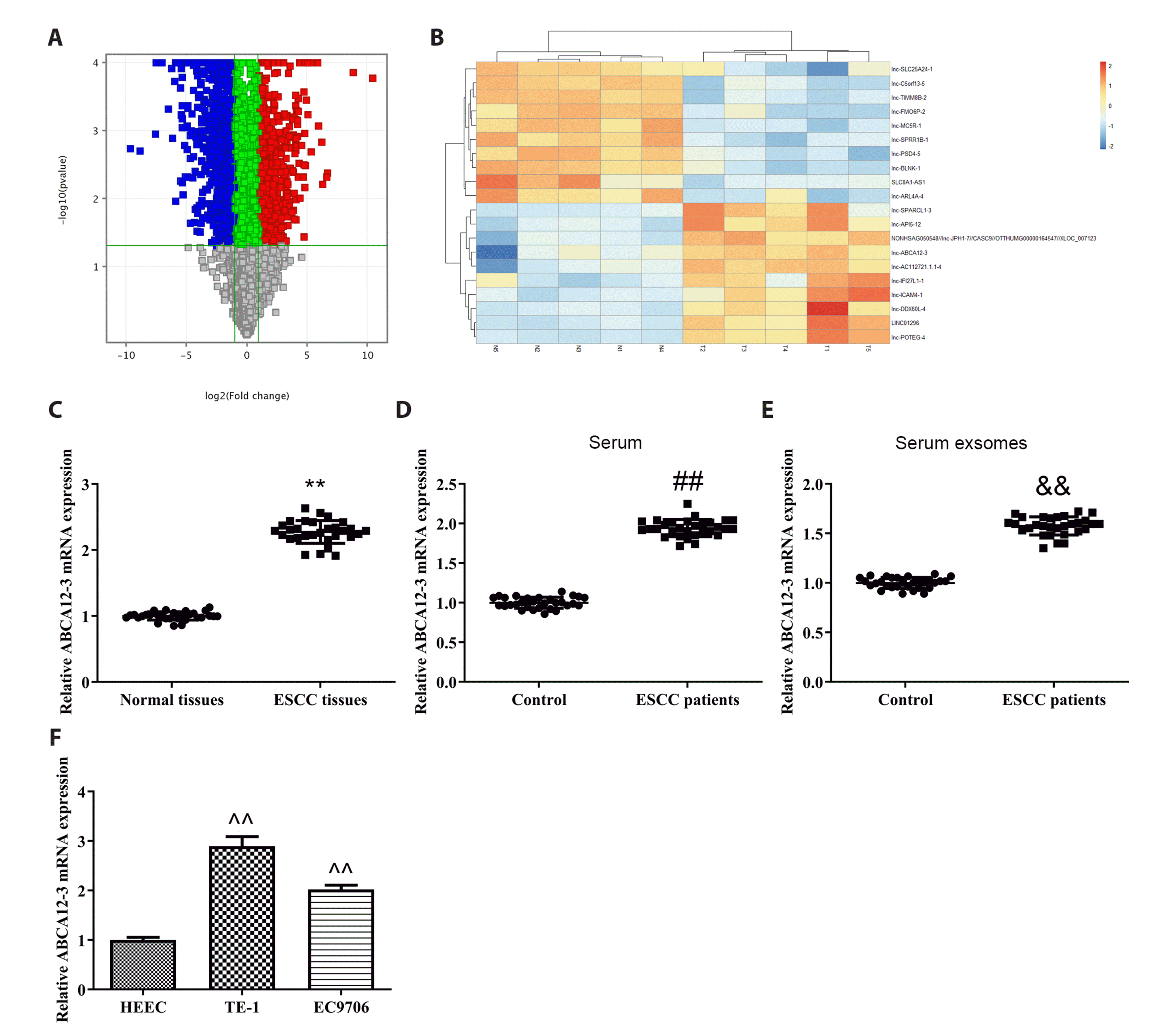
Fig. 2
Knockdown of lnc-ABCA12-3 inhibited the proliferation and glycolysis of esophageal squamous cell carcinoma (ESCC) cells.
(A) After transfection with sh-ABCA12-3, lnc-ABCA12-3 expression was measured by RT-PCR. (B) The viability of ESCC cells were assessed by CCK-8 assay. (C, D) The proliferation was detected by EdU assay. Scale bar, 20 μm. (E–G) The contents of ATP, glucose uptake, and lactic acid production were tested by the corresponding commercial kits. Data were presented as mean ± SD. **p < 0.01 vs. sh-NC group.
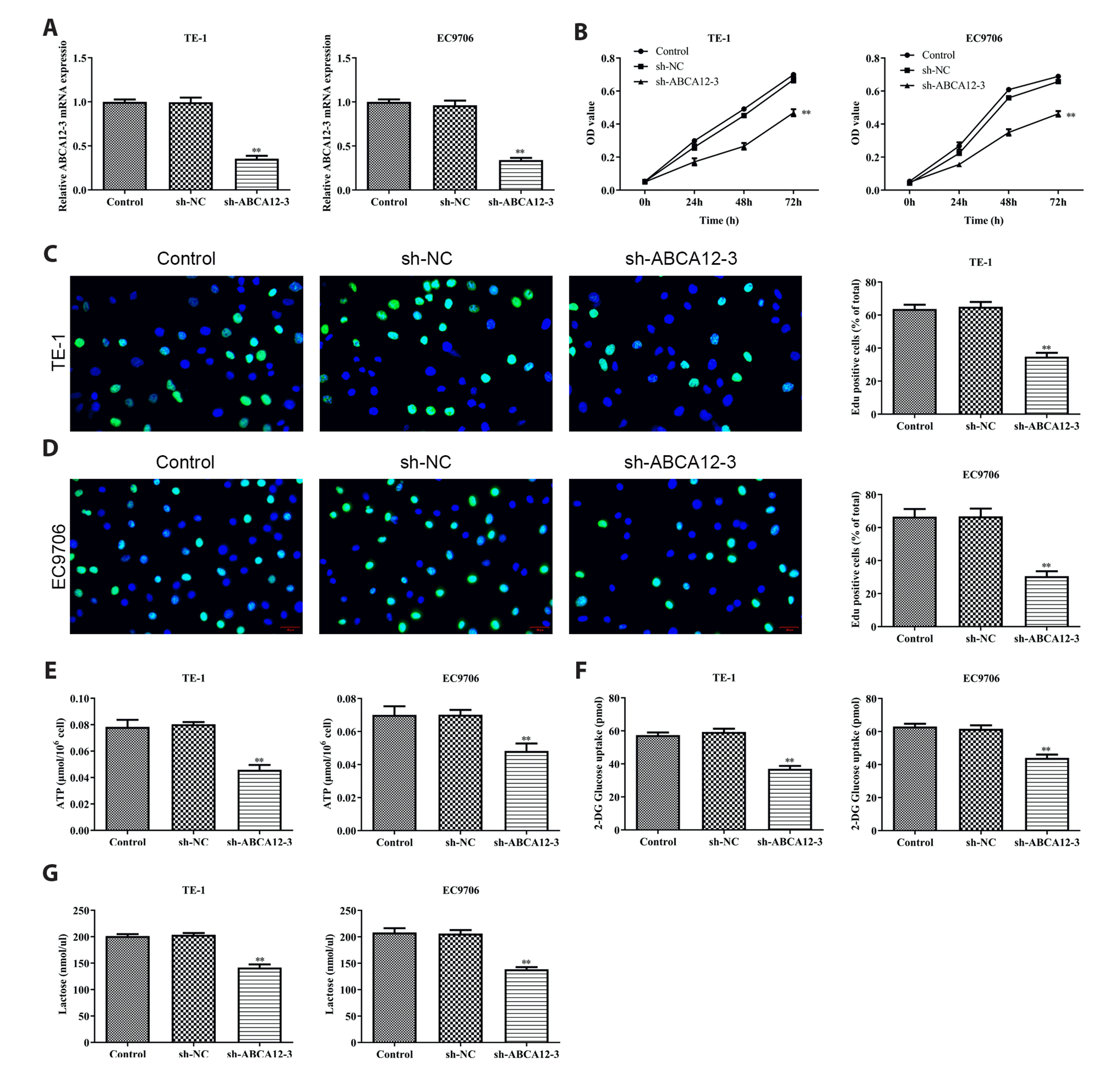
Fig. 3
Knockdown of lnc-ABCA12-3 promoted the apoptosis of esophageal squamous cell carcinoma (ESCC) cells.
(A, B) ESCC cells apoptosis were measured by flow cytometry. (C, D) The expression of Bax, Bcl-2, caspase-3, cleaved caspase-3 were detected by Western blot. Data were presented as mean ± SD. **p < 0.01 vs. sh-NC group.
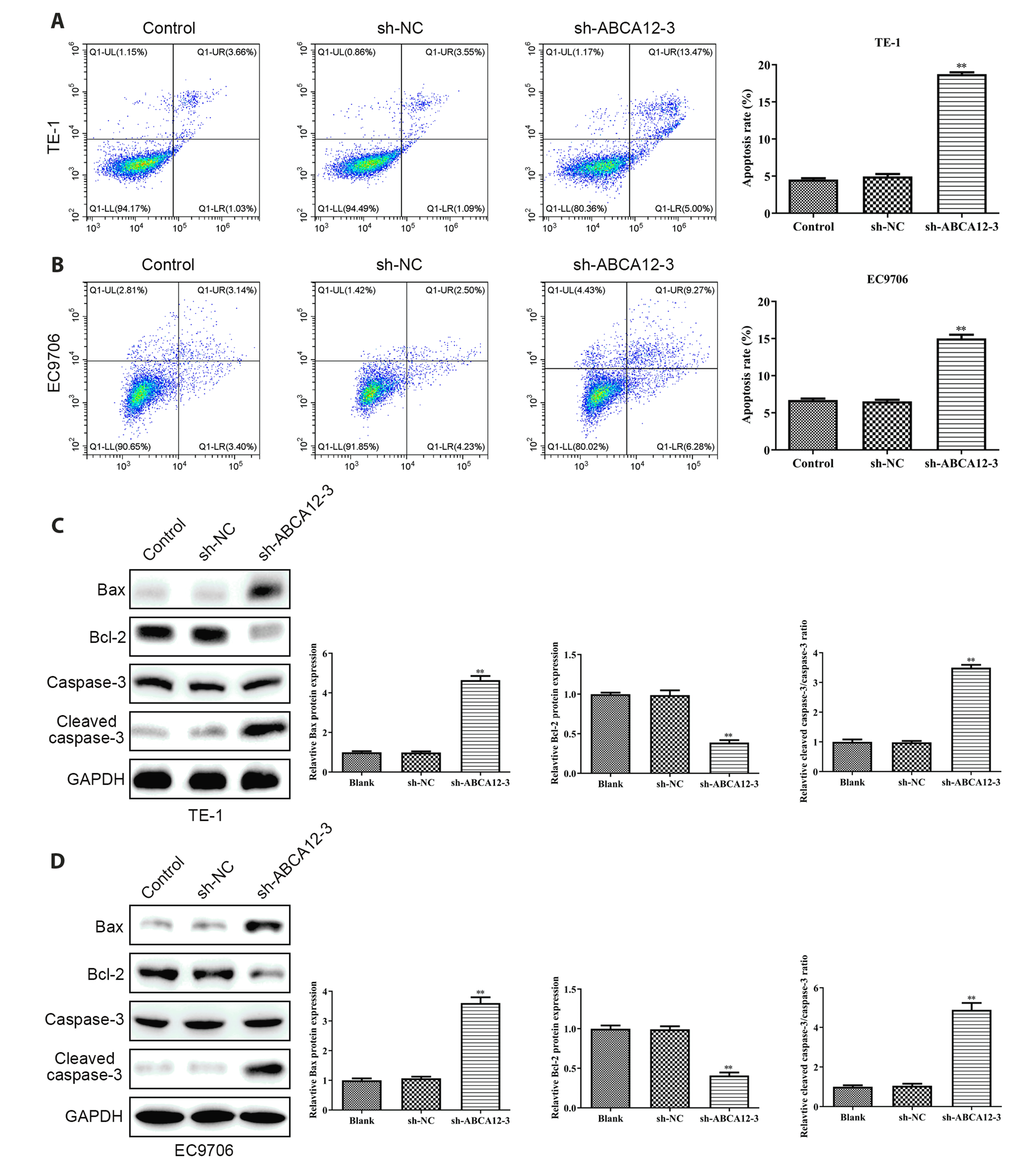
Fig. 4
Knockdown of lnc-ABCA12-3 inactivated toll-like receptor 4 (TLR4)/nuclear factor kappa-B (NF-κB) signaling pathway.
(A, B) The expression of TLR4, IκBα, p-IκBα, NF-κB, p-NF-κB were assessed by Western blot. Data were presented as mean ± SD. **p < 0.01 vs. sh-NC group.

Fig. 5
Lnc-ABCA12-3 regulated proliferation, glycolysis and apoptosis via activating TLR4.
(A) The viability of esophageal squamous cell carcinoma (ESCC) cells were assessed by CCK-8 assay. (B, C) The proliferation was detected by EdU assay. Scale bar, 20 μm. (D–F) The contents of ATP, glucose uptake, and lactic acid production were tested by the corresponding commercial kits. (G, H) ESCC cells apoptosis were measured by flow cytometry. Data were presented as mean ± SD. TLR4, toll-like receptor 4; LPS, lipopolysaccharide. **p < 0.01 vs. sh-NC group, ##p < 0.01 vs. sh-ABCA12-3 group.
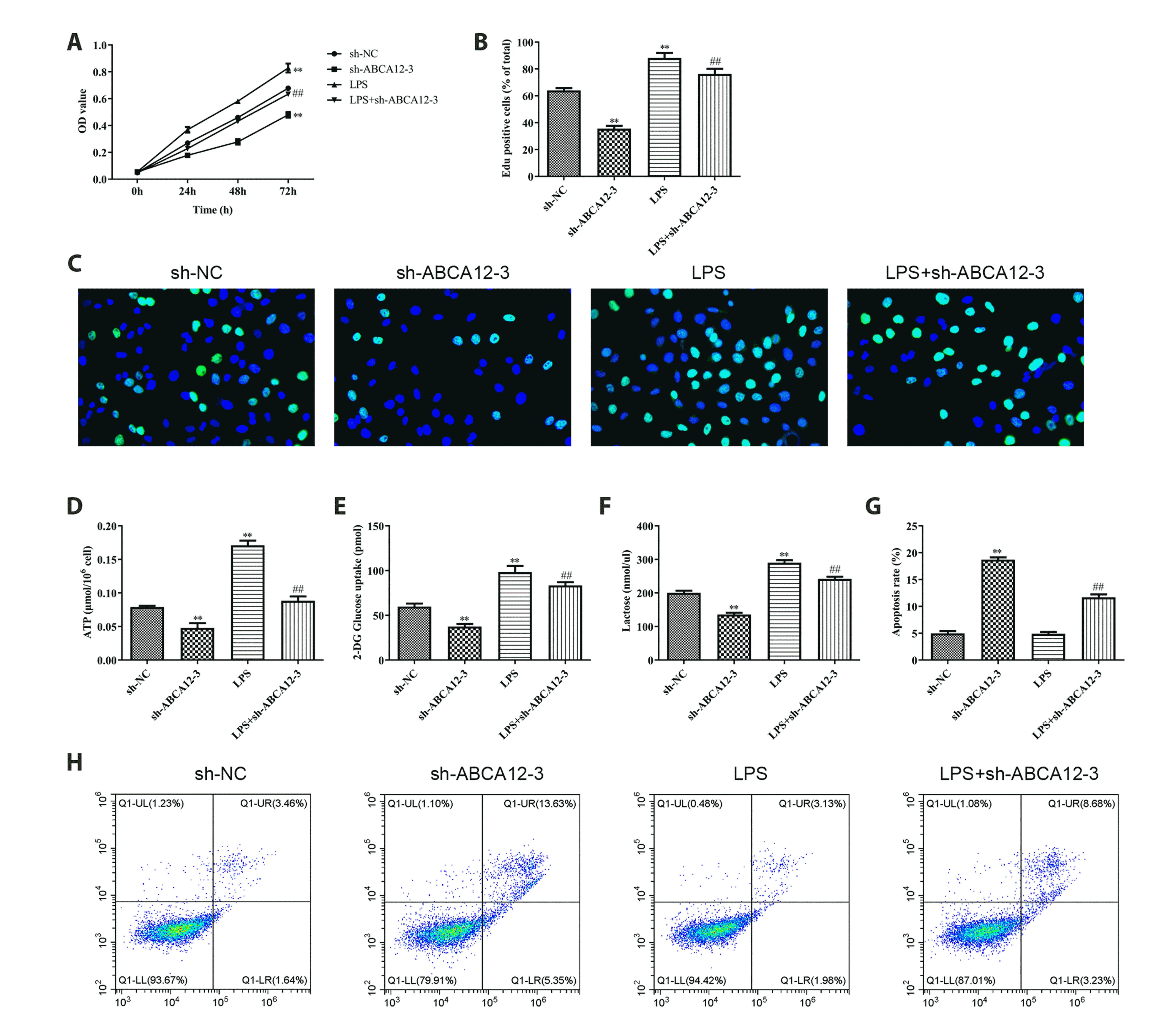
Fig. 6
The effect of lnc-ABCA12-3 on mitochondrial apoptosis pathway and toll-like receptor 4 (TLR4)/nuclear factor kappa-B (NF-κB) pathway in esophageal squamous cell carcinoma (ESCC) cells treated with LPS.
(A) The expression of Bax, Bcl-2, caspase-3, cleaved caspase-3 were detected by Western blot. (B) The expression of TLR4, IκBα, p-IκBα, NF-κB, p-NF-κB were assessed by Western blot. Data were presented as mean ± SD. LPS, lipopolysaccharide. **p < 0.01 vs. sh-NC group, ##p < 0.01 vs. sh-ABCA12-3 group.
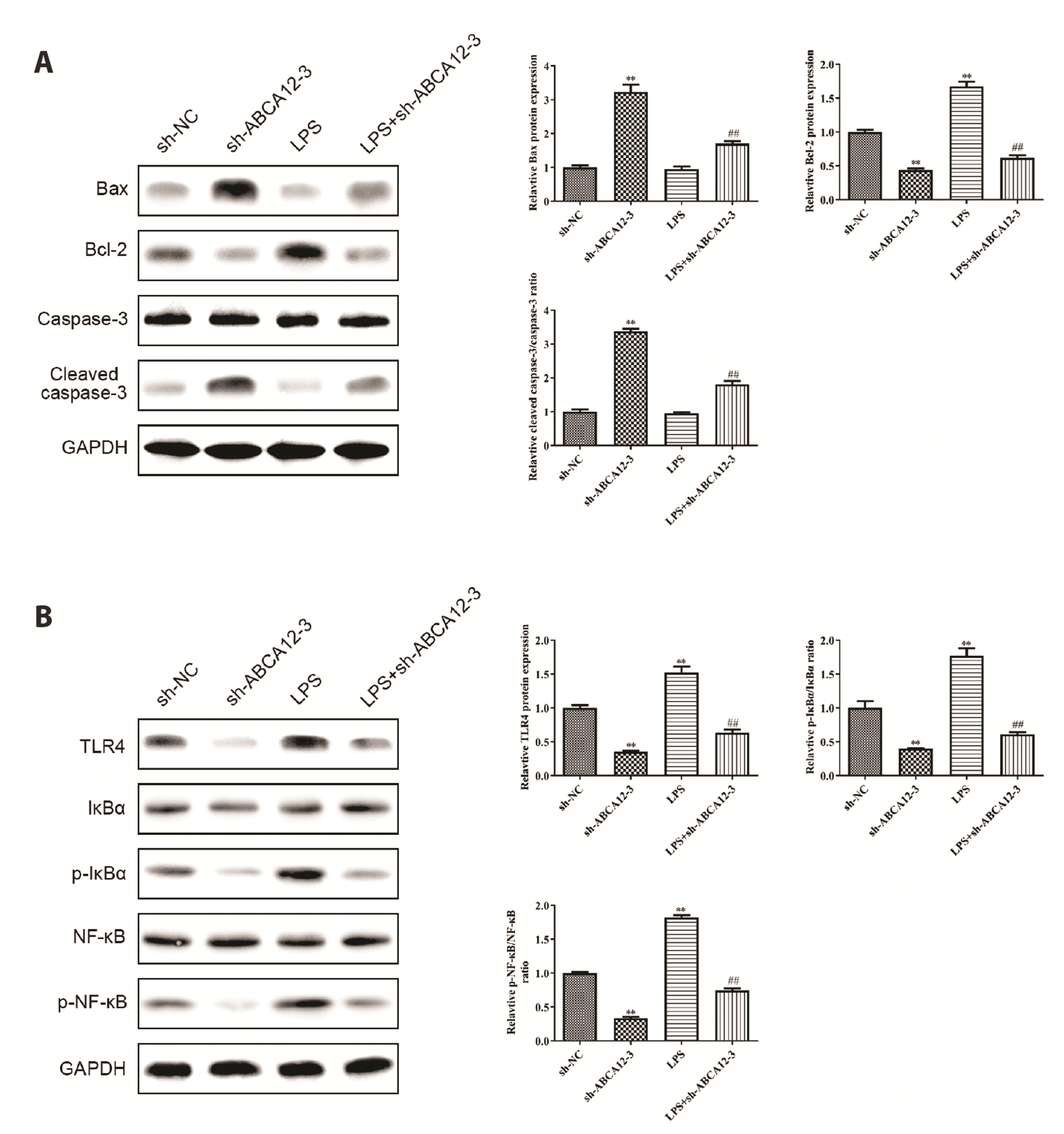
Fig. 7
Lnc-ABCA12-3 functioned with the esophageal squamous cell carcinoma (ESCC) cells was under the mediated of exosomes.
(A) After treatment with exosomes from TE-1 cells transfected with or without sh-ABCA12-3. Lnc-ABCA12-3 expression was measured by RT-PCR. (B) The viability of ESCC cells were assessed by CCK-8 assay. (C, D) The proliferation was detected by EdU assay. Scale bar, 20 μm. (E–G) The contents of ATP, glucose uptake, and lactic acid production were tested by the corresponding commercial kits. Data were presented as mean ± SD. **p < 0.01 vs. control group, ##p < 0.01 vs. TE-1-exo group, &&p < 0.01 vs. sh-NC-TE-1-exo group.
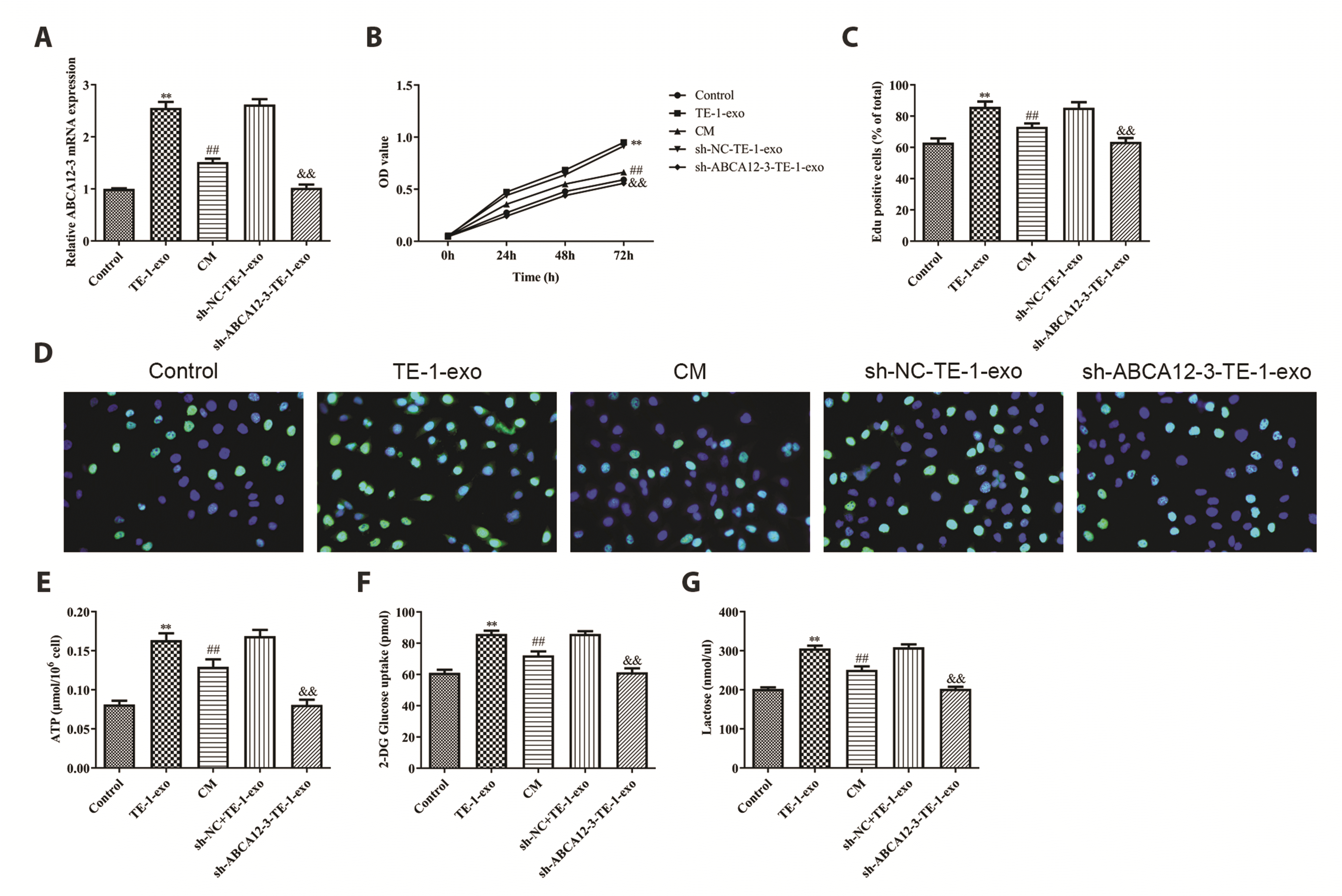
Fig. 8
Lnc-ABCA12-3 regulated mitochondrial apoptosis pathway and toll-like receptor 4 (TLR4)/nuclear factor kappa-B (NF-κB) pathway under the mediated of exosomes.
(A) The expression of Bax, Bcl-2, caspase-3, cleaved caspase-3 were detected by Western blot. (B) The expression of TLR4, IκBα, p-IκBα, NF-κB, p-NF-κB were assessed by Western blot. Data were presented as mean ± SD. **p < 0.01 vs. control group, ##p < 0.01 vs. TE-1-exo group, &&p < 0.01 vs. sh-NC-TE-1-exo group.





 PDF
PDF Citation
Citation Print
Print


 XML Download
XML Download